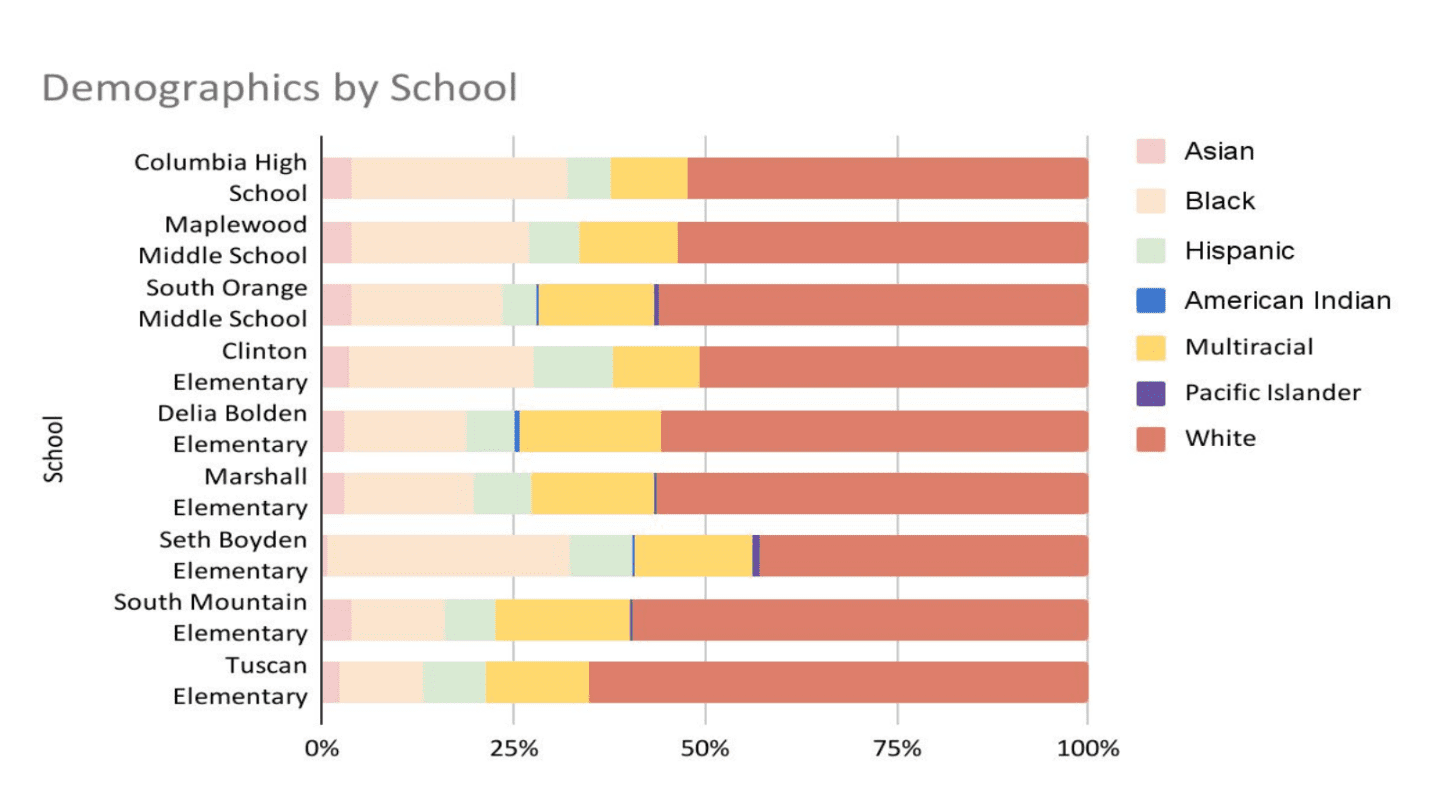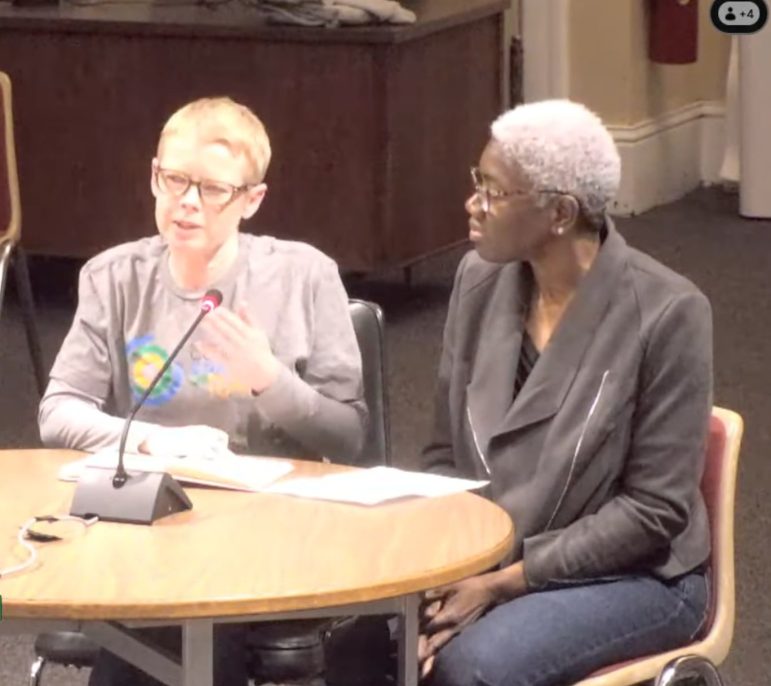Following two recent South Orange-Maplewood School District town halls — one on transportation and one on budget — where some community members questioned the continuation of the district’s Intentional Integration Initiative, the South Orange-Maplewood Community Coalition on Race is asking the school district and Board or Education to remain committed to the effort.
“There is no room for ‘yes, but’ when it comes to integration,” said Coalition on Race Schools Committee Co-Chair Erin Siders, who read a statement on behalf of the Coalition’s Schools Committee. “Either you are 100% for it or you are 100% against it…period. Some of the reasons stated are that it’s inconvenient, or that the cost of transportation has to go up to make it work. But if you’re against it for any reason, then you’re choosing segregation.”
“We’ve just been a bit concerned lately over some of the comments we’ve been hearing, some here, but mostly in the recent community forums hosted by [Supt. of Schools Jason Bing and SOMSD Business Administrator Imani Moody] regarding transportation and budget, regarding the integration initiative,” said Siders’ Co-Chair Jocelyn Ryan. “And we feel that maybe the community needs reminding of why it is that we are doing this.”
RELATED: SOMSD 2025-26 Budget: ‘No Reductions’ in Staff, 2.12% Total Tax Impact
To Ryan’s point, at a SOSMD Budget Town Hall on March 25, one comment submitted to the webinar chat read, “If the budget is such a huge concern, is there a way to make the case to defund III [the Intentional Integration Initiative] or look at it differently?”
Supt. Jason Bing responded, “We currently have an implementation committee in place at the Board level that has a new set of eyes on III and we’ll be looking at that throughout the year and making any appropriate revisions or modifications that we need to make. Getting rid of III at this point is not an option. This is a settlement. However, as I just noted, we have a board committee for the first time that is looking at our implementation plan and III with a new set of eyes. So we will take next school year as we look, if we need to make any revisions or modifications.”
In an email following Bing’s remarks, a district spokesperson clarified that the III is not the result of the district’s settlement with the Black Parents Workshop, although it appeared that Bing was referring to the Fergus Implementation Committee — now named the Rutgers Report Committee — in his comments; that committee is stipulated by the BPW settlement and meets quarterly. Ryan asked that updated minutes be made available from the implementation committee.
Now in its 5th year, the III has shown steady progress in racially balancing the elementary and middle schools. On January 30, 2025, Asst. Supt. of Access & Equity Dr. Kevin Gilbert presented data showing placements by grade for the III, as well as AP enrollment numbers at Columbia High School (which still lag in terms of Black student enrollment). Bing announced on March 27 that the district’s III vendor — The Alves Group — would be presenting more data at an upcoming meeting.

From SOMSD Intentional Integration & Student Enrollment in Advanced Courses, January 30, 2025, Dr. Kevin F. Gilbert, Assistant Superintendent of Access and Equity
The III has experienced some bumps in the road in its five-year history: In 2023, the Board expanded busing to support the III after parents complained about the loss of so-called “courtesy” busing and dozens filed appeals over the loss of hazardous routes busing (a judge ruled that the district had violated its own transportation policy). Additionally, the Board has made some policy changes that would allow for administration to create a socio-economic status (SES)-neutral portal for transfers “without undermining the III.” (The III algorithm does not consider race, but uses SES in placing students.)
Siders noted, “Before the Intentional Integration Initiative, we had two schools that were roughly 70% white, and one that was roughly 70% Black. That’s what happens when you have neighborhood schools. And it’s de facto segregation.”
She added, “For 28 years, the Coalition on Race has been pushing for a truly equitable school district. We know that this work is hard. It’s messy, it’s complicated, it’s uncomfortable, it’s challenging. But when you believe something is vital, important, necessary and VALUED – you have to be all in, even for the parts that are not easy. We are all in. We hope that the District, the Board, and the community share our view that there is no point at which integration isn’t worth the fight.”

Jocelyn Ryan (left) and Erin Siders at the March 27, 2025 South Orange-Maplewood Board of Education meeting.
Read Siders’ full remarks from the South Orange/Maplewood Community Coalition on Race Schools Committee here:
If you ask South Orange-Maplewood residents why they moved here, one of the top reasons is always the diversity.
Celebrating diversity seems to be acceptable when talking about the various housing stock, houses of worship, or restaurant options.
But when we talk about diversity in our schools, and making sure our school demographics reflect our community…we hear “yes, but…”. “I believe in integration, but my child needs to attend this particular school because…”
There is no room for “yes, but” when it comes to integration. Either you are 100% for it or you are 100% against it…period.
Some of the reasons stated are that it’s inconvenient, or that the cost of transportation has to go up to make it work. But if you’re against it for any reason, then you’re choosing segregation.
Brown v Board of Education was 71 years ago. Two years ago, a New Jersey Supreme Court judge found that the state has a duty to address de facto segregation in our schools. Before the Intentional Integration Initiative, we had two schools that were roughly 70% white, and one that was roughly 70% Black. That’s what happens when you have neighborhood schools. And it’s de facto segregation.
For 28 years, the Coalition on Race has been pushing for a truly equitable school district. We know that this work is hard. It’s messy, it’s complicated, it’s uncomfortable, it’s challenging.
But when you believe something is vital, important, necessary and VALUED – you have to be all in, even for the parts that are not easy.
We are all in. We hope that the District, the Board, and the community share our view that there is no point at which integration isn’t worth the fight.
For the sake of all our students, present and future, don’t dismantle this good work because it’s hard.









